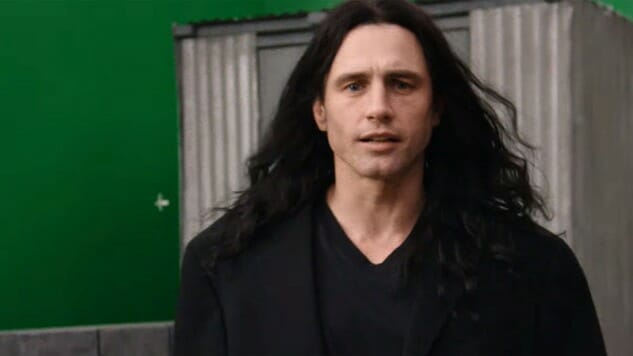The Disaster Artist and the Canonization of Unintentional Comedy
Comedy Features The Disaster Artist
Okay, so, it’s a fragmented cultural landscape that re-fractures itself more and more every year, yada yada yada. This we know. Which is why it’s especially fascinating that these days the only thing everyone can agree on as funny is something that isn’t good. Any internet-using human of a certain age and their parents either already know about “disappointed!,” “they’re eating her, and then they’re going to eat me,” Kirk vs. Gorn, etc., or they will have no problem understanding why it’s funny: it’s bad. That’s all you need to know.
While we’ve long had a fascination with so-bad-it’s-good media, it’s a relatively recent phenomenon that these clips would become so ubiquitous as to support a major motion picture about the creation of one of them. For most people, The Disaster Artist is basically about the making of “oh hai, Mark.” That cultural moment is on full display in James Franco’s take on the troubled production and bromance behind The Room, “the Citizen Kane of bad movies.” At its best, The Disaster Artist is a deeply painful character study on misplaced ambition featuring a mesmerizing lead performance. Other times, its celebrity recreations of viral beats from The Room feel a little like the U.S. Olympic swimming team, or whatever, posting their take on the Harlem Shake.
It is, however, a story that earns being told, because despite his ambiguous origins, Tommy Wiseau (played by Franco) is a uniquely American character: a man who has felt promised something by movies, and if he can’t get there on his own terms he’ll turn the entire world into “Planet Tommy.” He tells his roommate and only friend Greg Sestero (Dave Franco, playing the author of the film’s source material) that Planet Tommy is a place where everyone loves each other, but we know that it’d simply be a world where somebody, anybody, gives Tommy an ounce of the respect he craves.
The movie mines a lot from pairing these grand themes of insecurity, jealousy and betrayal with something so unbelievably dumb, but the story of Tommy Wiseau is equally represented within The Room itself. “This my movie,” he tells the audience at the film’s premiere, “and this my life.” Which is why, despite The Disaster Artist’s many merits, the celebrity intro telling us how incredible The Room is and the mid-credits coda that shows how faithfully its scene were recreated feels so unnecessary. We already know The Room, if only by reputation, and if we bought a ticket we have come prepared to take its story seriously. Still, Franco’s insistence on including these bookends in The Disaster Artist and our insistence that we don’t need them reflects how our collective attitude towards The Room has grown from curiosity to respect and defensiveness. Evidence of this shift populates little moments throughout The Disaster Artist: it is not a coincidence that the movie’s first real needle drop sees Tommy and Greg singing “Never Gonna Give You Up” (the “rickrolling” song), or that Judd Apatow’s cameo as a powerful producer begins with him asking his date what she thinks about Jar Jar Binks.
It’s also worth noting how markedly different the film is from its clearest predecessors. Best Worst Movie, Michael Stephenson’s excellent documentary about the making of Troll 2, approaches its subject with almost journalistic rigor. Tim Burton’s Ed Wood is a fully romantic love letter to bad movies, done with a more specific stylistic flourish. That movie, however, doesn’t make the leap that The Disaster Artist does, because even in 1994 the incompetence of Ed Wood’s filmography operated within an already understood definition of camp that the film itself uses as a filter. Franco’s film, despite some wonderfully horrible beard and wig work on Dave Franco and Josh Hutcherson that reads as self-referential, has more straightforward prestige biopic aspirations. As a result it suffers the pitfalls of the genre that smart a little, creatively, in a post-Walk Hard world, and politically, in a post-Weinstein one. Biopics are legacy fantasies, restructuring events so that one’s accomplishments always justify their process, and as The Disaster Artist sees it, Tommy’s atrocious, abusive behavior on set is somehow completely vindicated by his backwards success.
With late night TV bending over backwards to capture and recreate the virality of whatever we, the audience, has decided to watch, The Room is now as ripe for adaptation within the Hollywood system as the life of Howard Hughes or Mozart or Mark Zuckerberg. Max Cea, writing about Wiseau’s recent appearance on Jimmy Kimmel Live! in Salon, noted that he “was being let into the Hollywood cool kids club, but only for their amusement.” That may be true for the man, but whether A24’s Oscar campaign for The Disaster Artist pays off or not, The Room itself and entertainment of its kind has already long since made itself a seat at the table.
Graham Techler is a New York-based writer and actor. Follow him at @grahamtechler.